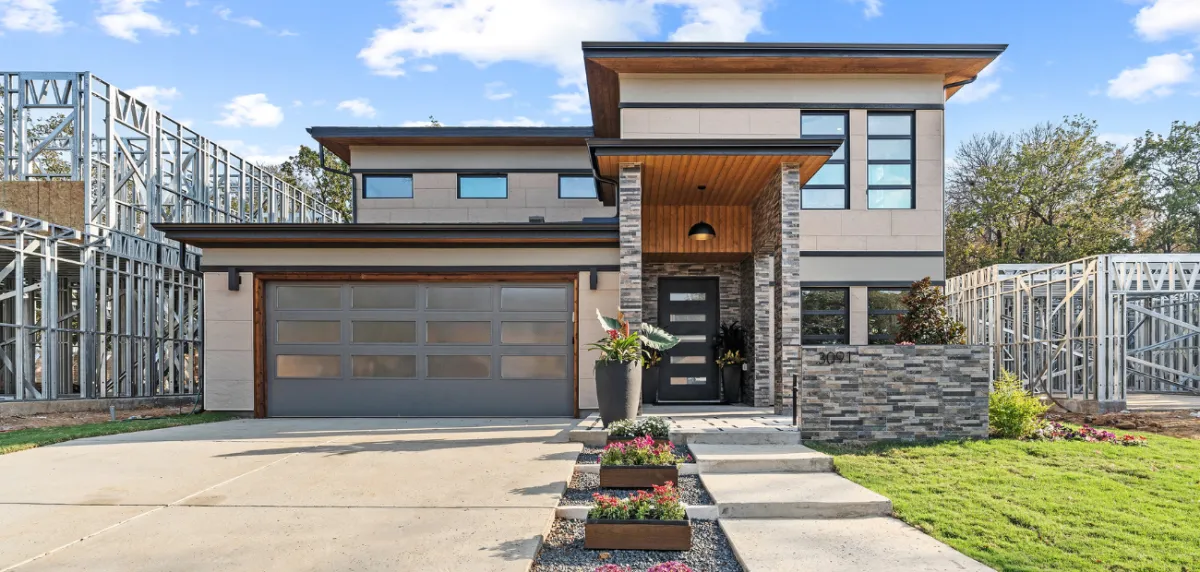Real Estate and Design Trends to Watch in 2024

From ecosystem conservation to “new” darker neutrals in exterior paint, we look at the trends set to take hold in the industry this year.
Staying abreast of what’s new and innovative in design and real estate is important, not to be trendy but to learn about innovative materials, systems and products to live more sustainably and benefit the planet. Also, new uses for rooms can maximize square footage and our surroundings to add joy to our lives. The following 10 trends are worth considering since they can positively influence whether homeowners reside in single- or multifamily housing.
Homeowners Are More Apt to Stay Put
With interest rates for a 30-year fixed mortgage still high, home prices holding steady and inventory still low, many homeowners plan to stay put, optimizing or expanding their existing square footage. Laurel Vernazza, Home Design Expert at The Plan Collection— Scarsdale, N.Y.-based company that sells pre-drawn plans—says that for those with no plans to move, the wish list includes:
- Sustainable features
- Accessory dwelling units as zoning laws change
- Pickleball courts
- Remodeled basements with saunas
- Media centers and game rooms
- Home offices as working from home continues
- Outdoor space, not just at ground level but above as well
- AI-driven technology to make homes easier to use and more energy-efficient
Why now? Homeowners want to be active but decrease maintenance and energy consumption. They favor sustainable materials sourced locally to pare carbon footprints and support local businesses, which is especially true for millennials and Generation Z. Many materials reflect better waterproofing, and garages may have room for battery back-up systems if power goes out, says architect Jonathan Boriack, AIA, LEED AP, principal with KTGY in Oakland, Calif.
Specialized Needs for an Aging Population
Architectural firms like The Architectural Team (TAT) outside Boston are designing facilities for specialized needs, such as The Cordwainer, which will have private and double rooms and a host of amenities including a two-story atrium, performance center, game room to stimulate the brain, and memory care garden. The bedrooms will be divided between two neighborhoods so residents can safely wander, says TAT architect Anthony Vivirito. Also critical is light to help with circadian rhythms and mood. “Biophilic elements and the focus on unique spaces for invigorating activities and entertainment required stepping away from traditional practices,” says Tamilyn Liesenfeld, president and CEO at Anthemion Senior Lifestyles, which owns and operates The Cordwainer in Norwell, Mass.
Why now? With aging boomers numbering 76.4 million, more attention is paid to their housing needs when they can’t stay at home, which includes many of the estimated 6.7 million who have Alzheimer’s disease.
Smaller Single-Family Homes and More Townhomes
Variety is the spice of homebuilding. Currently, homes are shrinking in size(link is external), with the median for single-family houses at 2,261 square feet and the mean square footage of new single-family homes down to 2,469, according to the National Association of Home Builders. One of the most popular styles is the ranch house. The style also offers the flexibility to be opened up indoors and to the outdoors, according to Vernazza. Attached townhomes and stacked flats have gained popularity due to the need for smaller square footage in dense sites, says Boriack.
Why now? The main reasons(link is external) for smaller single-family homes are high mortgage rates and lifestyle changes that favor fewer bedrooms. As far as townhomes and stacked flats are concerened, the economics of for-sale property works with current market finances more for developers than rentals do. Land shortages make attached and stacked units smart choices.
Bigger Apartments
At the same time that single-family homes are shrinking, apartments are increasing from an average of 870 square feet before the pandemic to closer to 1,000 square feet, says architect Sean M. Stadler, FAIA, LEED AP, a managing principal with WDG Architecture’s Washington, D.C. office.
Why now? Many renters want more space to work from home and favor more bedrooms, if they can afford, Stadler says.
Homeowners Want Sustainable Energy Use
Sustainability isn’t going anywhere. In fact, it’s growing in popularity, and received a boost in January 2023, when the Department of Energy(link is external) announced federally backed incentives to help builders make DOE-certified Zero Energy Ready Homes their standard. An example of a builder focused on both energy efficiency and lower construction waste is Netze Homes, based outside Dallas, which uses steel that it recycles from cars. It claims its houses are 20 times stronger than those built from wood. Since the frame is built in a factory to exacting specifications, the homes are tighter and the resulting lower air exchange makes them more efficient.




